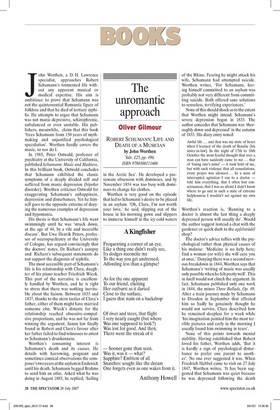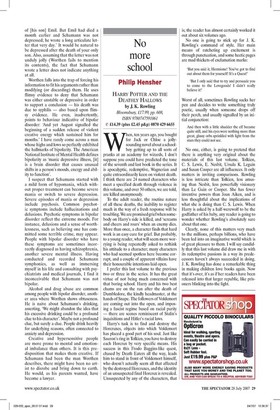The unromantic approach
Oliver Gilmour ROBERT SCHUMANN: LIFE AND DEATH OF A MUSICIAN by John Worthen Yale, £25, pp. 496, ISBN 9780300111606 John Worthen, a D. H. Lawrence specialist, approaches Robert Schumann's tormented life without any apparent musical or medical expertise. His aim is ambitious: to prove that Schumann was not the quintessential Romantic figure of folklore and that he died of tertiary syphilis. He attempts to argue that Schumann was not manic-depressive, schizophrenic, unbalanced or even unstable. His publishers, meanwhile, claim that this book 'frees Schumann from 150 years of mythmaking and unjustified psychological speculation'. Worthen hardly covers the music, so nor do I.
In 1985, Peter Ostwald, professor of psychiatry at the University of California, published Schumann: Music and Madness. In this brilliant book, Ostwald concludes that Schumann exhibited the classic symptoms of a deeply divided self and suffered from manic depression (bipolar disorder). Worthen criticises Ostwald for exaggerating Schumann's unhappiness, depression and disturbances. Yet he himself goes to the opposite extreme of denying the numerous examples of depression and hypomania.
His thesis is that Schumann's life went swimmingly until he was 'struck down, at the age of 44, by a vile and incurable disease'. But Uwe Henrik Peters, professor of neuropsychiatry at the University of Cologne, has argued convincingly that the doctors' notes, Dr Richarz's autopsy and Richarz's subsequent statements do not support the diagnosis of syphilis.
The most accessible part of Schumann's life is his relationship with Clara, daughter of his piano teacher Friedrich Wieck. This part of the narrative is excellently handled by Worthen, and he is right to stress that there was nothing inevitable about the liaison. Between 1833 and 1837, thanks to the stern tactics of Clara's father, either of them might have married someone else. Wieck's distaste for the relationship reached obsessive-compulsive proportions, and he was not far from winning the argument. Saxon law finally found in Robert and Clara's favour after her father failed to find witnesses to attest to Schumann's drunkenness.
Worthen's consuming interest is Schumann's death and its causes. He details with harrowing, poignant and sometimes comical observations the composer's two years at the asylum in Endenich until his death. Schumann begged Brahms to send him an atlas. Asked what he was doing in August 1885, he replied, 'Sailing in the Arctic Sea'. He developed a passionate obsession with dominoes, and by November 1854 was too busy with dominoes to change his clothes.
Worthen is very good on the episode that led to Schumann's desire to be placed in an asylum. 'Oh, Clara, I'm not worth your love,' he said, slipping out of the house in his morning gown and slippers to immerse himself in the icy-cold waters of the Rhine. Fearing he might attack his wife, Schumann had attempted suicide. Worthen writes, 'For Schumann, having himself committed to an asylum was probably not very different from committing suicide. Both offered sane solutions to senseless, terrifying experiences.'
None of this should shock us to the extent that Worthen might intend. Schumann's severe depression began in 1833. The author concedes that Schumann was 'thoroughly down and depressed' in the autumn of 1833. His diary entry noted: Awful life.., and that was my state of heart when I learned of the death of Rosalie [his sister-in-law]. In the night of 17th to 18th October the most fearful thought that ever a man can have suddenly came to me ... that of 'losing one's mind' — it took hold of me, but with such violence that all consolations, every prayer was silenced ... In a state of interrupted agitation I ran to a doctor — told him everything, that I often lost consciousness, that I was so afraid I didn't know where to go and in such a state of extreme helplessness I wouldn't act against my own life.
Worthen's reaction is, 'Running to a doctor is almost the last thing a deeply depressed person will usually do'. Would the author suggest instead a chat with the gardener or quick dash to the apfelstriidel shop?
The doctor's advice tallies with the psychological rather than physical causes of his malaise: 'Medicine is no help here; find a woman (or wife) she will cure you at once.' Denying there was a second nervous breakdown in 1844, Worthen says that Schumann's 'writing of music was usually only possible when he felt pretty well'. This in itself would not clinch the argument. In fact, Schumann published only one work in 1844, the minor Three Ballads, Op. 49. After a train journey made by Schumann to Dresden in September that affected him so badly he genuinely thought he would not survive, Clara described how he remained sleepless for a week while 'his imagination painted him the most terrible pictures and early in the morning I usually found him swimming in tears'.
None of this points towards mental stability. Having established that Robert loved his father, Worthen adds, 'But it is hardly a sign of psychological disturbance to prefer one parent to another'. No one ever suggested it was. When Friedrich Hebbel came to visit on 27 July 1847, Worthen writes, 'It has been suggested that Schumann was quiet because he was depressed following the death of [his son] Emil. But Emil had died a month earlier and Schumann was not depressed; he wrote a long articulate letter that very day.' It would be natural to be depressed after the death of your only son. Also, assuming that the letter was not unduly jolly (Worthen fails to mention its contents), the fact that Schumann wrote a letter does not indicate anything at all.
Worthen falls into the trap of forcing his information to fit his arguments rather than modifying (or discarding) them. He uses flimsy evidence to deny that Schumann was either unstable or depressive in order to support a conclusion — his death was due to syphilis — also based upon flimsy evidence. He even, inadvertently, points to behaviour indicative of bipolar disorder: 'And yet August signalled the beginning of a sudden release of violent creative energy which sustained him for months.' I have rarely come across a man whose highs and lows so perfectly exhibited the hallmarks of bipolarity. The American National Institute of Mental Health defines bipolarity as 'manic depressive illness, [it] is a brain disorder that causes unusual shifts in a person's moods, energy and ability to function'.
I suspect that Schumann started with a mild form of hypomania, which without proper treatment can become severe mania or switch to severe depression. Severe episodes of mania or depression include psychosis. Common psychotic symptoms include hallucinations and delusions. Psychotic symptoms in bipolar disorder reflect the extreme moods. For instance, delusions and a sense of worthlessness, such as believing one has committed some terrible crime, may appear. People with bipolar disorder who have these symptoms are sometimes incorrectly diagnosed as having schizophrenia, another severe mental illness. Having conducted and recorded Schumann symphonies, as well as immersing myself in his life and consulting with psychiatrists and medical journals, I find it inconceivable that Schumann was not bipolar.
Alcohol and drug abuse are common among people with bipolar disorder, another area where Worthen shows obtuseness. He is naive about Schumann's drinking, asserting, 'We might abandon the idea that his excessive drinking could be a profound clue to his character'. Maybe not a profound clue, but surely a clue. People drink heavily for underlying reasons, often connected to anxiety and depression.
Creative and hypersensitive people are more prone to mental and emotional imbalance than others. It is this predisposition that makes them creative. If Schumann had been the man Worthen describes, there might have been no artist to disrobe and bring down to earth. He would, as his parents wanted, have become a lawyer.









































 Previous page
Previous page